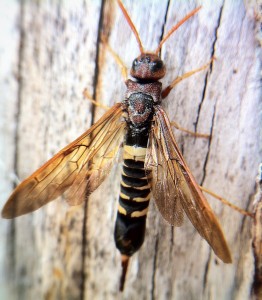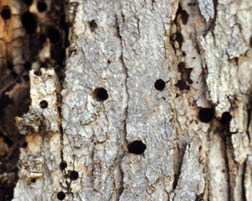Now that September has arrived and everyone is thinking of the cold weather ahead. Don't forget that yellow jackets are still quite active and more agressive!
During the summer yellow jackets are more docile because the colony stays busy collecting insects and rearing larvae. In the fall the workers change their foraging behavior bringing them into contact with people and pets more frequently. No longer are they feeding on insects such as spiders, caterpillars and flies. Their diets turn to sugary food sources such as fruits, ice cream, flower nectar, beer, and soft drinks, to name a few. Because supplies are limited they also become very aggressive and will sting more willingly. The reason for the need to feed on sugary substances is to supply the developing queens back at the nest with food so they can mate and over winter.
Most often homeowners have several nests on their property. Depending on the size of the nest, it could actually have as many as 50 to 100 queens that will venture out in the spring starting new nests in the same area as the original nest because conditions are quite favorable for the new colonies to thrive.
Keep in mind that yellow jackets are most often ground nesters and sometimes the only way that you realize that you have a problem is when you come into contact with them. They are usually discovered during lawn maintenance and in some instances the swarmers will attack if provoked.
Now is the time to get rid of the old nests. By removing or destroying any active nests in the fall you are eliminating the developing queens from starting new nests and colonies in the spring.
To insure that the nests are destroyed properly contact your local pest control company and schedule an inspection.
The horntail wasps get their name from the projection on the back of their abdomen. Many people think it is a stinger. Some people refer to these insects as wood wasps. This is because the larvae bore into wood. Adult horntails are large insects. Depending on the species, their size ranges between 12 to 40 mm. They are dark colored, usually brown or black. Some species have pale markings. Horntails do not bite or sting and are sometimes noisy when they fly.
They cause concern to homeowners when they appear  inside homes. They are brought into the home inside of wood that is used for structural lumber or other wood products. They are sometimes brought in inside of firewood that is stored in the home.
inside homes. They are brought into the home inside of wood that is used for structural lumber or other wood products. They are sometimes brought in inside of firewood that is stored in the home.
Female horntails deposit their eggs into the trunks of trees. Most species choose coniferous, softwood trees, but a few species choose broadleaf, hardwood trees. The trees are usually in decline from disease or attack from other insects. When the eggs hatch, the larvae burrow into the wood. The larvae of the horntail make tunnels in the wood. They pack the tunnels with droppings and wood shavings as they burrow. When the larvae are full grown, they burrow close to the surface of the wood. They make a silken cocoon inside the tunnel. The larva changes into an adult inside the tunnel. In the forest, horntails can complete the entire life cycle in a year or two. If the wood has been dried and made into lumber, the horntail life cycle can take as long as five years. When the adult comes out of the cocoon, it chews its way out of the wood. The adult makes a round hole in the surface of the wood. The exit holes are usually about ¼” in diameter.
 Exit Holes in Tree Trunks may be a sign of a horntail infestation
Exit Holes in Tree Trunks may be a sign of a horntail infestation
Adult horntails that emerge in the living space of a home can cause a disturbance. The exit holes can be unsightly, especially in wood that has been painted or stained.
In most cases, it will not be necessary to do anything to control horntails. The adult horntail does not reinfest seasoned wood. It will not lay eggs in wood that is inside the home. Damaged wood can often be repaired or replaced. Firewood should not be stored inside the home. Firewood should only be brought in when it will be used.




































































